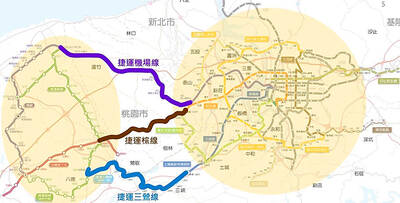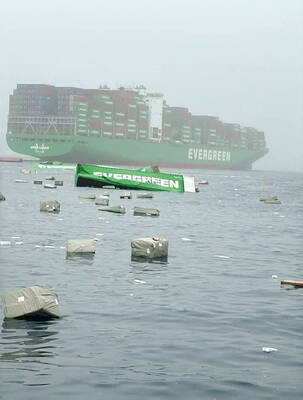Businesses can soon apply for licenses to test their own 5G networks, as the National Communications Commission (NCC) is planning to publicize regulations governing privately managed 5G networks in the first quarter this year.
Compared with 4G, 5G networks have a lower latency, higher capacity and increased bandwidth, the commission said.
Aside from consumer-oriented applications, 5G technology offers companies opportunities to create new devices and facilitate their production processes, it added.
The commission has since 2019 allowed companies to test concepts with practical potential on the 4.8 Gigahertz (GHz) to 4.9GHz band.
Since last year, it has received 29 proof-of-concept applications, including from HTC, Panasonic Taiwan, Quanta Computers and Chunghwa Telecom.
Chunghwa Telecom and the Ministry of Economic Affairs have built an independent 5G network in the Start-up Terrace in New Taipei City’s Linkou District (林口).
Panasonic Taiwan and Quanta Cloud Technology, a subsidiary of Quanta Computers, use their own 5G network to transmit high-definition images that enable assembly line workers at headlight manufacturing plants to install parts more accurately.
In contrast to consumer-oriented networks run by telecoms, companies’ internal 5G networks are not open to the public, NCC Vice Chairman and spokesman Wong Po-tsung (翁柏宗) said yesterday.
“Previously, we gave private companies special permission to test a concept or theory using the frequency band, but in the future they can also obtain a license to access the band,” Wong said.
“The regulations governing the license applications are scheduled to be released in the first quarter of this year, followed by a 60-day public comment period,” he added.
Companies can begin filing applications once the regulations are finalized, he said.
Licenses for private 5G networks would be issued after a review by the NCC commissioners rather than through a public tender, Wong said, adding that band usage fees would be charged from licensed firms.
The commissioners would examine the application based on criteria including coverage, management and security of a private 5G network, as well as the projected bandwidth, Wong said.
Meanwhile, the commission is to subsidize telecoms NT$5.5 billion (US$197.64 million) this year for building 5G base stations.
In November last year, one-and-a-half years after 5G was launched in Taiwan, the nation had about 25,000 base stations, with a service coverage rate of 87 percent and 4.38 million users, or 18.76 percent of the population, NCC data showed.
This compares with 10.08 million 4G users 18 months after that service was launched in 2014, it said.

“China is preparing to invade Taiwan,” Deputy Minister of Foreign Affairs Francois Wu (吳志中) said in an exclusive interview with British media channel Sky News for a special report titled, “Is Taiwan ready for a Chinese invasion?” the Ministry of Foreign Affairs said today in a statement. The 25-minute-long special report by Helen Ann-Smith released yesterday saw Sky News travel to Penghu, Taoyuan and Taipei to discuss the possibility of a Chinese invasion and how Taiwan is preparing for an attack. The film observed emergency response drills, interviewed baseball fans at the Taipei Dome on their views of US President

ECONOMIC BENEFITS: The imports from Belize would replace those from Honduras, whose shrimp exports have dropped 67 percent since cutting ties in 2023 Maintaining ties with Taiwan has economic benefits, Ministry of Foreign Affairs officials said yesterday, citing the approval of frozen whiteleg shrimp imports from Belize by the Food and Drug Administration (FDA) as an example. The FDA on Wednesday approved the tariff-free imports from Belize after the whiteleg shrimp passed the Systematic Inspection of Imported Food, which would continue to boost mutual trade, the ministry said. Taiwan’s annual consumption of whiteleg shrimps stands at 30,000 tonnes, far exceeding domestic production, the ministry said. Taiwan used to fill the gap by importing shrimps from Honduras, but purchases slumped after Tegucigalpa severed diplomatic ties with Taiwan

The Executive Yuan yesterday approved a southwestern extension of the Sanying MRT Line from New Taipei to Bade District (八德) in Taoyuan, with a goal of starting construction by late 2026. The 4.03-kilometer extension, featuring three new stations, will run from the current terminus at Yingtao Fude Station (LB12) in New Taipei City to Dannan Station (LB14), where it will connect with Taoyuan’s Green Line, New Taipei City Metro Corp said in a statement. This extension will follow the completion of core Sanying Line, a 14.29-kilometer medium-capacity system linking Tucheng (土城), Sansia (三峽)

CARGO LOSS: About 50 containers at the stern of the ‘Ever Lunar’ cargo ship went overboard, prompting the temporary closure of the port and disrupting operations Evergreen Marine Corp, Taiwan’s largest container shipper, yesterday said that all crew members aboard the Ever Lunar (長月) were safe after dozens of containers fell overboard off the coast of Peru the previous day. The incident occurred at 9:40am on Friday as the Ever Lunar was anchored and waiting to enter the Port of Callao when it suddenly experienced severe rolling, Evergreen said in a statement. The rolling, which caused the containers to fall, might have been caused by factors including a tsunami triggered by an earthquake in Russia, poor winter sea conditions in South America or a sudden influx of waves,